 | The Xenophile Historian |

 |
 |
 |
 |
 |
 |
 |
A Concise History of India
Chapter 1: ANCIENT/CLASSICAL INDIA
Before 600 A.D.

This chapter covers the following topics:

Introduction
Before I begin, I should give some facts about the land and people of India so that one can understand their history properly:
Together the lands of India, Pakistan, Bangladesh, Nepal, Bhutan, Sri Lanka and the Maldive Islands are called a subcontinent because natural barriers isolate them from the rest of Asia. Chief among these is the Himalaya mts., "the Roof of the World," which runs for 1,600 miles along the northern frontier. The Baluchistan desert and the world's second highest mountains, the Karakoram range, continue the barrier west to the Arabian Sea, and the jungles of Myanmar (formerly Burma) complete it on the eastern end. The only easy way to get through this barrier is via the mountain passes in the northwest; Khyber Pass, on the Afghan-Pakistan border, is the most famous of these. Consequently, most of India's invaders came in from the northwest. Once they were in, the same geographical barriers discouraged attempts to leave again, so the descendants of these raiders(1) usually stayed in India. The only major exception was the British, who came from the sea.
Once they were through the passes and across the Indus River, the invaders had a choice between the blistering Thar desert to the south, and a fertile plain called the Punjab to the east. Naturally most of them chose the Punjab, and many battles that determined India's future were fought here. East of the Punjab was India's other great river, the Ganges. The Ganges is the heart of India today, but the forests along and the heavy monsoon rains made it less inviting than the Indus at first. Civilization developed in the Indus valley in the third millennium B.C., but 2,000 years went by before the Ganges valley had cities too. The swampy delta of Bengal presented an even greater challenge and was not civilized until 300 B.C. The easternmost region, between Bengal and Myanmar, is called Assam, a land of hilly jungles split by the Bramaputra River, which flows out of Tibet to join the Ganges in Bengal. Assam's main ethnic group is related to the Thais, and geographically and culturally, this region was part of Southeast Asia, rather than India, until the British took it in 1826.
South of the Ganges, the 3,000 foot-high Vindhya mountain range separates northern India from the south. Its dense forests, peopled by savages, prevented the southward spread of civilization until the third century B.C. Many military and romantic legends have been created by the struggles between civilized men and the forest peoples of the Vindhyas; in isolated pockets these tribes still maintain their primitive way of life.(2)
Most of southern India is occupied by a plateau called the Deccan. It is bordered on the east and west by two mountain ranges that parallel the coast, the eastern and western Ghats. The Deccan is not very hospitable, being quite dry in most places (the monsoon season here only lasts six weeks) and split by canyons with jungle-lined rivers where water can be found. Farthest to the south is the land where the Tamil people live, a fully tropical land with mountains (the Cardamons) reaching to 8,000 feet. The Tamils have always been interested in commerce, and much of India's seagoing trade went through Tamil ports.
It is not only geography that divides the land; the people themselves are divided! For most of Indian history they have divided the subcontinent into many small states. Uniting them is a formidable task, and the only government that succeeded in ruling the entire subcontinent for more than a generation was a foreign one--the British! There is no place on earth where more languages and dialects are spoken (the New Delhi government recognizes 1,652). Many of these languages are Indo-European, distantly related to English, while others may come from those spoken by the land's original inhabitants, 5,000 years ago. In much of the subcontinent, you only have to travel fifty miles to come upon a completely different culture.
Another problem with Indian history comes from the Indian view of time. Few Indians have been interested in their own history; in fact, they didn't think they had a history until archeologists discovered it! Alexander the Great, for example, is not mentioned once in Indian records, although he conquered the Indus valley and the Punjab; apparently the locals didn't think he was so great. This attitude comes from the idea, no doubt derived from the theory of reincarnation, that time goes around in circles. To the Hindu mind, what will happen has happened before, what has not happened will never take place in the future, so what's the point in studying the past?(3)
Since the subcontinent became independent of British rule in the mid-twentieth century, some new factors have made the above attitude more complicated. From 600 B.C. onward, we can use the records of other civilizations (e.g., Persia, Greece, China, etc.) to check on what is happening in India. For the period before India made contact with those civilizations, written records exist in the form of Sanskrit literature (the Vedas, see below), but they do not tell us how Indian civilization got started. Consequently, what we know about pre-classical India comes mainly from what the archaeologists have found. This has encouraged Hindu nationalists to fill in the blanks, looking for any way to prove, for reasons of national pride, that the Indian civilization is the oldest in the world. In that sense, it is much like the game of one-upmanship the Egyptians, Babylonians and Greeks had around 200 B.C., when Manetho, Berosus and Eratosthenes all claimed that their civilization was the oldest. Therefore the dates used in this chapter will be the ones most widely accepted. In addition, you will hear the nationalists argue that the Indus Valley civilization's inhabitants spoke Sanskrit, while the conventional view is that they spoke a Dravidian (south Indian) language; they are also fond of exaggerating the age of Indus Valley sites. Wildest of all are reports of submerged cities found off India's coast; since we assume these were on dry land during the ice age, when sea levels were lower than they are today, claims have been made that India's continental shelf is the lost continent of Lemuria, and that the cities could be as much as two million years old! Thus, I have learned to take any news story about ancient India with a healthy dose of skepticism; there's a good chance it will be revised or disproved by the next discovery!
Finally we should mention religion, since it has always been an important part of Indian life. The Indians are probably the most religious people in the world today. Today you can find Hindus, Moslems, Buddhists, Sikhs, Jains, Christians, Jews and Parsees (Zoroastrians) there. The history of India is both religious and political; what passes for Indian history is a combination of undated facts and outright legends. This has often made it hard for historians to understand India's past, because the most reliable sources of information come from non-Indians. This interest in religion rather than politics has also affected India's role in the world community; unlike the West, few Indians have had a vision of empire-building, and the only place where they tried to spread Indian culture was Southeast Asia.
But now, on with our story . . .
The Indus Valley Civilization
The first civilization of the Indian subcontinent arose on the banks of the Indus River, in modern Pakistan. This civilization was completely forgotten in the dark age that followed its end; British archeologists rediscovered it in the 1850s, where nobody thought such a civilization existed. The two largest cities of the civilization are called Harappa and Mohenjo-Daro; also important were cities like Lothal, Dholavira, Chanhu Daro, Ganweriwala, and Rakhigarhi; 1,400 sites have been discovered and excavated altogether. Another river used to run parallel to the Indus; it contains even more sites from the civilization than the Indus itself, and is believed to be the Ghaggar-Hakra or the Sarasvati, a river mentioned in Hindu literature that no longer exists. Most historians call it the Indus Valley or Harappan civilization, while Hindu nationalists call it the Sarasvati civilization, to divert attention from the fact that the most important sites are in Pakistan.

A map showing several of the Indus Valley civilization's sites.
Whatever you want to call this civilization, it covered an impressive amount of ground: at least 300,000 square miles, more than any other early bronze age civilization. This is four times as much land as ancient Sumer, and twice as much land as Egypt ruled during the Old Kingdom. Besides most of Pakistan, there were settlements on India's west coast; the southernmost was in the state of Maharashtra, about 150 miles north of Bombay. To the east, they also colonized the Punjab, stopping just before reaching the headwaters of the Ganges. Finally, there was a Harappan colony at Shortugai, on the banks of the Amu Darya in northern Afghanistan. Shortugai was one of two known places where lapis lazuli was mined (the other was in Baluchistan); this purple semi-precious stone was very popular in Egypt and Mesopotamia, so it became a valuable commodity to trade with those civilizations. The population of the whole area may have reached as high as 5 million people. Harappa and Mohenjo-Daro used the same weights and measures, and the layout of the two cities is so much alike that they could have been designed by the same architect. For these reasons, we believe the civilization was a unified state, though we do not know the nature of its government, nor do we know which city was the capital. Not until Sargon I built his empire in the Middle East (about 2100 B.C.) would there be a nation as large as this elsewhere.
It appears that the Indus civilization got started at Mehrgarh, a 495-acre area located west of the Indus, in modern Baluchistan. Here the remains of several villages have been found, whose people had a neolithic (new stone age) technology. The villages weren't all inhabited at the same time; when one was abandoned, a new one would be founded. At least eight occupation levels were identified at the site by the archaeologists who excavated it; they dated the oldest level to 7000 B.C., and the youngest to 2500 B.C. The residents lived in mud-brick huts, and while the presence of wild animal bones show that hunting took place, over time agriculture became the most important livelihood: they herded cattle, sheep and goats, and grew wheat, barley, jujubes and dates. In their graves they buried the dead with beads made of stone and shells, and baskets that presumably carried food originally. From clay they made pottery and figurines, and in some occupation levels there is evidence of copper and bronze work. When Mehrgarh was abandoned for the last time, our guess is that the residents moved to Nausharo, a Harappan town three miles to the south, for the communities on the Indus itself were fully developed by now.
Because of Baluchistan's western location, within reach of the Sumerians of Iraq and the Elamites of Iran, it is tempting to believe that people from those civilizations settled the Indus valley. However, the age of the Mehrgarh villages, and the long, slow development they indicate, suggest that Indians did most of the work to build their civilization by themselves. Still, their trade with the Persian Gulf and Central Asia must have helped, because traders carry ideas as well as merchandise. The Indus valley provided conditions similar to those found in Egypt and Mesopotamia: moderate temperatures caused by moderate latitudes (about 30o North), not much rainfall, and a stoneless plain that was extremely fertile, from the soil brought down by floods. In those days, the Indus valley was greener than it is today, with plenty of trees and game animals. Because of that, those who moved into the valley did not have a great struggle to survive, but much work and organization was required to live well. The organization was needed to irrigate farms, store surplus food, obtain vital raw materials like stone and metal ore from elsewhere, and to conduct trade/diplomacy with communities outside the valley.
Archaeologists have noted three phases of development in Indus valley communities, and give them the following names and dates:
3300-2600 B.C. = Early Harappan Period.
2600-1900 B.C. = Mature Harappan Period.
1900-1300 B.C. = Late Harappan Period.
The Early Harappan Period saw the communities grow slowly, and then suddenly around 2600 B.C., they were replaced by fullfledged cities. At their peak, Harappa and Mohenjo-Daro may have held as many as 50,000 people, and they were marvels of city planning. Whereas most ancient cities have streets winding every which way, because the residents put up houses and other buildings wherever they wanted, Indus valley cities were the first to lay out their streets in a grid pattern. Buildings conformed rigidly; two structures that served the same purpose looked alike, with no fancy frills like columns or windows to tell them apart. An ingenious sanitation system provided water to many houses of the city, and efficiently disposed of trash and sewage; the drains included "inspection openings" at intersections, which like today's manholes, allowed checking and cleaning. Overall the network of wells, conduits and trash bins is better than what is found in much of India even today. In the center of each city were ventilated granaries(4), a citadel to house the rulers, and a large pool, which appears to have been used for ritual bathing, still a common practice among modern-day Hindus.
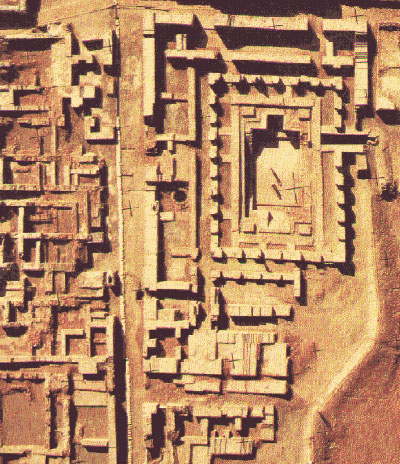 |
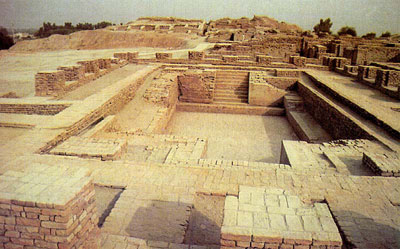 |
Two views of Mohenjo-Daro, showing the pool from the air and the ground.
If Harappan society was efficient, it was also very utilitarian. The pottery has only simple decorations, and we do not have paintings of the people in everyday activities, like the paintings other cultures made at the time (e.g., the Egyptians and Minoans). The rulers did not build monuments to themselves, or leave inscriptions telling about their achievements. Evidently the Harappan elite did not believe in the saying "If you got it, flaunt it!" Art seems to have been for private consumption; all we have found so far are jewelry, toys for children (clay models of animals, boats and wheeled carts), and a few small sculptures like the ones below:
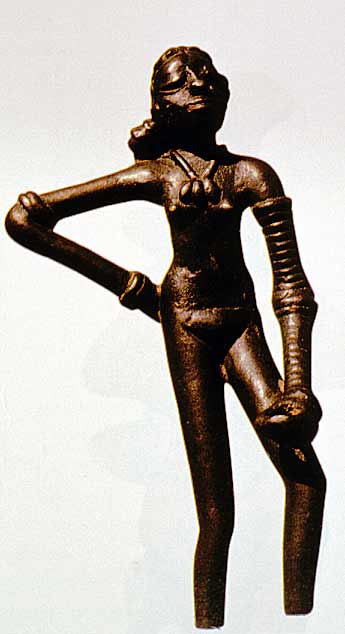
This 4.5-inch bronze statuette represents a dancing girl. Except for a necklace and an armload of bangles, she is nude. Dancing is still popular in India today, but the dancers wear clothes.
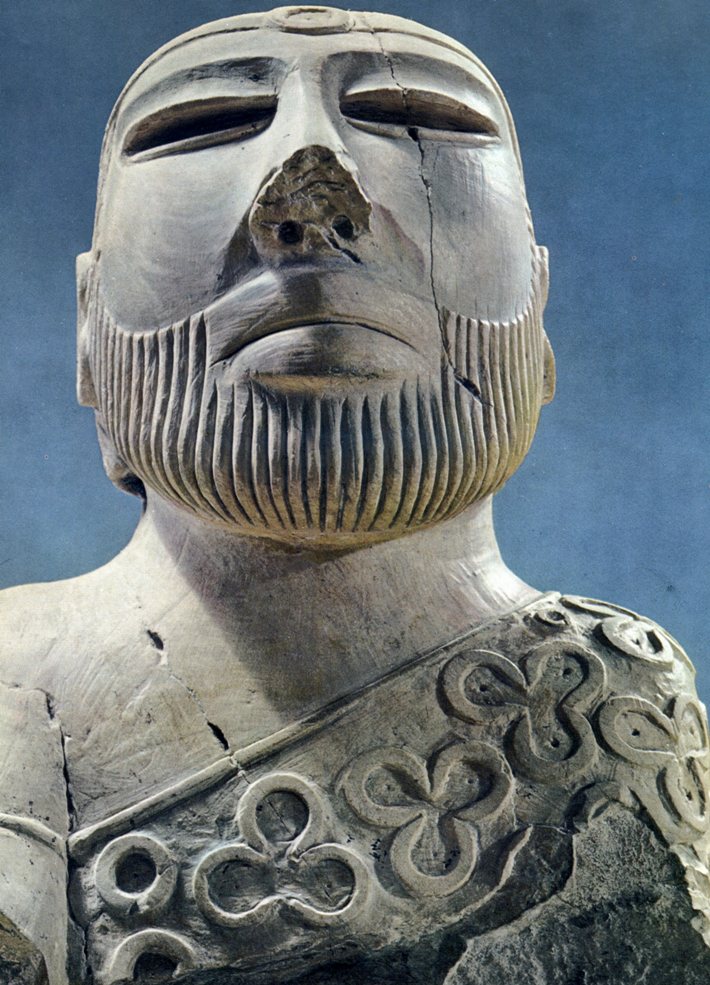
A 7.5-inch bust of an important official. Unfortunately there is no identification; he could be a priest, a king, or a god, and in ancient societies he could be more than one of the above. The trifoil pattern on his robe can represent leaves, or a religious symbol like the Trinity (later on, the gods Brahma and Shiva would be portrayed with three faces).
The reason why we know so maddeningly little about the Indus civilization is because we have not deciphered its system of writing. The best examples of it that we have are on stone seals; each seal has a picture in its center, and an assortment of symbols on the top. A few symbols have also turned up on copper plates and pottery. So far 419 symbols have been identified, too many for a phonetic alphabet, but not enough for a pictographic system like Egyptian hieroglyphics. Our first problem is that we donít have anything like the Rosetta Stone, an artifact where the Indus Valley script appears alongside an identical script in a language we already know.(5) The second problem is that the inscriptions are so short; the longest found so far, on a signboard near a city gate, is only twenty-six symbols long. It is possible that longer inscriptions may have been written on some perishable medium (Wood? Papyrus? Leaves? Cloth or animal hides?), but after decades of excavations, no evidence of this has turned up; indeed, some scholars have suggested that the Harappans learned to write their names, but never got beyond that point. As for the picture in the center of each seal, we think it represents the family or clan of the seal's owner. The most common picture is a one-horned animal we call a "unicorn" (probably a bull in profile), so the "unicorn clan" may have been the ruling class or caste.
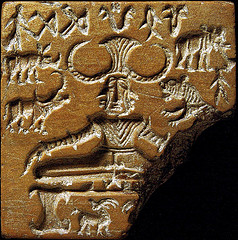 |
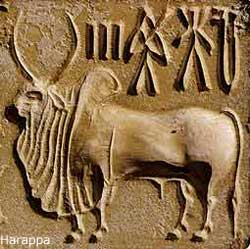 |
Two Harappan seals bearing the mysterious script. The main pictures are of a horned deity (Proto-Shiva?) and a zebu (Brahman) bull.
As for the identity of the Harappan people, most scholars believe they were ancestors of the Dravidian peoples that live in south India today. Presumably the Dravidians had the whole subcontinent originally, but were driven out of the north when the Indo-Europeans arrived (see the next section). Modern examples of Dravidian languages include Telugu and Tamil; one Dravidian group, the Brahui, lives in western Pakistan, suggesting that they managed to hold on in Harappan country after their cousins moved south.
Judging from the above video, we may finally have a way to decipher the Indus script. An Indian computer scientist, Rajesh Rao, shows how he is programming computers to look for anything in the symbols that could tell us something about their meaning. For example, he believes the symbols are the names of planets and stars as well as people, and that the Harappans, like modern Dravidians, were named after objects in the sky that astrologers believe were important on the day they were born.
Figuring out what kind of religion they practiced is also difficult; if the cities had temples, they have not been identified. The local religion seems to have been fertility-oriented, with worship practiced in homes or at the ritual pool. Judging from images on their stone seals, the chief Harappan deity was very much like the Hindu god Shiva, if not the same; he used some of the symbols that would be associated with Shiva later on (the bull, an erect phallus, or a man with many faces). Likewise, several clay figurines of women have been found, and they are thought to represent a mother goddess, a forerunner of Hinduism's Mahadevi.
We know the Indus valley civilization conducted trade because more than a dozen Harappan stone seals have been found in Iraq and Bahrein; a few seals have also turned up in the recently discovered bronze age cities of Central Asia (the BMAC or Oxus civilization). In return, a few Mesopotamian-style cylinder seals have been found in the Indus valley. Trade was especially important for the port of Lothal; archaeologists have uncovered that city's docks.
The earliest trade records from Iraq report that the three countries the Sumerian city-states traded the most with were Dilmun, Magan, and Meluhha. There is general agreement among scholars that Dilmun had to be Bahrein, and Magan was probably Oman; Meluhha is the country we are still unsure about. Currently the most popular theory is that Meluhha was the Indus Valley civilization, because from the Persian Gulf it is in the same direction as Magan (Magan and Meluhha are usually mentioned together), and the trade goods obtained from Meluhha were available in India: timber, ivory, gold and carnelian.(6) From the west the Indians imported copper, silver, tin, and wool, which are scarce in India--maybe oil and grains as well.
The Harappan civilization had remarkable staying power. For centuries, whenever a flood or earthquake damaged one of its cities, they would rebuild it, brick for brick, on the same pattern. In the outside world, not even the Egyptians displayed this much conservatism. However, after 1900 B.C., the Late Harappan Period arrived, and the cities slipped into permanent decline. Sir Mortimer Wheeler, the archaeologist who excavated Mohenjo-Daro in the mid-twentieth century, noted deteriorating conditions and remarked that the great city was "becoming a slum." Houses built on the ruins of older dwellings "were increasingly shoddy in construction, increasingly carved up into warrens for a swarming lower-grade population." In other words, the late Harappan population was both larger and poorer than the population of earlier periods.
No single cause appears responsible for the decline. The climate became drier, causing crop failures with increasing frequency, and turning the Indus valley into a desert. The Indus River changed its course after floods, and the Sarasvati dried out completely; both were bad news to those living on the riverbanks. Man-made activities may have played a role, too. Bad land management practices could have ruined the fertility of the soil, or poisoned it with salt leached up from the water table. Flocks of sheep and goats could have overgrazed, and loggers could have caused similar damage to the ecology by felling too many trees. An examination of bones from Harappan cemeteries revealed an increasing number of cases of leprosy and tuberculosis; no doubt disease epidemics raised stress levels during the declining years. Finally, the trading network probably broke down; by 1700 B.C. the Sumerians had been replaced in Iraq by the Babylonians, and the Central Asian cities were abandoned.
Meanwhile, a new, warlike race was moving into the area. These people called themselves Aryans (from Arya, meaning "noble" or "kinsmen"), and were part of the wandering confederation of Indo-European tribes (see below). First they conquered Afghanistan, then they moved across the mountains into India. The rulers of the Harappan cities responded to the danger by strengthening the walls of their citadels, but not the walls of the cities. We have found some bronze weapons in the cities, but no picture of what their soldiers looked like; nor have we found any evidence of slaves, oppression or unrest in the cities. Still, could the strengthening of the citadel walls be a sign that the rulers feared their own subjects more than the Aryans?
At some point between 1700 and 1500 B.C., both Harappa and Mohenjo-Daro were abandoned. We used to believe that they came to a violent end, because Sir Mortimer Wheeler found sprawling skeletons in the topmost level of Mohenjo-Daro, bearing injuries that looked like sword or axe cuts. A second look at the bones, however, revealed that only one skeleton is likely to belong to a person who died from those wounds. The other wounds were either inflicted on already-dead bodies, or came from injuries that happened long before their deaths. Most important of all, there is no "layer of destruction"; Harappan cities don't have a layer of ash and rubble, like what archaeologists find in ancient cities that were sacked/burned down.
Now it looks like the smaller cities were ruined first by floods, drought, etc., and refugees crowded into Harappa and Mohenjo-Daro; hence, the crowding and poverty we already noted during the last years of those cities. The residents in turn left the big cities when life in them became unbearable (the skeletons might have been plague victims), moving either south down the subcontinent's coast, or east to the Ganges valley. Cities in those directions, like Lothal, lasted longer than those on the Indus, until 1300 B.C. Other refugees joined the stone-age tribes living in India's forests. One of the last places abandoned was Pirak, a town in Baluchistan; it held out until 800 B.C.
No other ancient civilization was destroyed as completely as this one. Whereas many monuments and some of the lore of Egypt, Mesopotamia, and pre-Columbian America have survived their overthrow, we know the culture of the Indus valley through archaeology alone. A dark age now descended upon India, lasting for nearly a millennium. When the curtain rose again, around 600 B.C., a different civilization would be there, one centered on the Ganges River rather than the Indus.
The Vedic Age
Behind the ex-city-dwellers came the Aryans, who occupied the ruined cities as squatters, and left Afghan-style pottery and ramshackle dwellings where the granaries and courtyards used to be. They called their war-god, Indra, the "fort destroyer," presumably because their opponents lived in fortified communities. Indeed, one of their hymns (Rig Veda VI.27.5) mentions a battle at a place called "Hariyupiyah." It is tempting to see Hariyupiyah as another name for Harappa, but in this hymn, the attackers were defeated outside the city walls. Apparently the Aryans, for all their military skill, did not take the great cities until they had fallen from within. More likely they came into India in several migratory waves, rather than one invasion force, with the last arriving as late as 900 B.C.
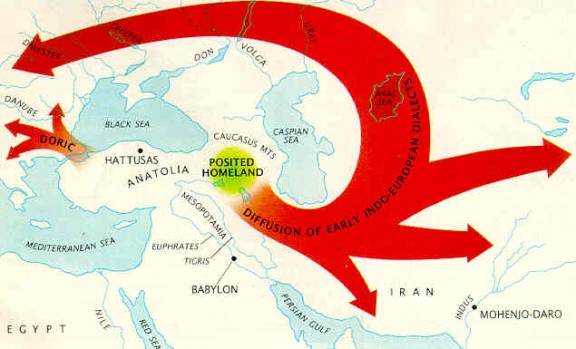
A simplified map of the Indo-European migration. Source: Uncp.edu.
The Aryan newcomers were a light-skinned Japhetic people; sometimes we call them Indo-Iranians because they were related to the Medes and Persians of Iran. They were a proud race of nomads, who lived by herding cattle and making war upon their neighbors. When they went to battle, they brought the best armaments of the second millennium B.C.: compound bows, swords, and most of all the chariot, a new weapon that had an equally devastating impact when it was introduced in the Middle East and China around the same time. Most of what we know about the Aryans comes from their literature; they did a remarkable amount of thinking for uncivilized people. Like their distant relatives in Europe, the Greeks, they were insatiably curious about the world around them. During this time they composed songs and prayers in their language, Sanskrit, passing them down by word of mouth for centuries until they invented a Sanskrit alphabet. We know these verses as the Vedas, and because of their importance the preliterate era (1500 to 600 B.C.) is called the Vedic Age.
The earliest of the Vedas, 1028 hymns called the Rig Veda, were composed before 900 B.C.; some describe geographical landmarks in Afghanistan and were probably composed before the Aryans arrived in India. Chieftains called rajas and priests called Brahmans already existed at this time, though class distinctions were loose compared to the caste system of later eras. The descriptions of their chief foes, the dasyus or dasas ("slaves"), allowing for the normal exaggeration of propaganda, give us an accurate look at the Indus culture. They are portrayed as short dark demons with unbecoming features like thick lips and flat noses. They were wealthy, living luxuriously in fortified places. Most loathsome was their worship of the phallus.(7)
In spite of these expressions of contempt, there was interaction between the Aryans and the conquered Dravidians. The Sanskrit language picked up non-Aryan words as time went on. Religions and cultures must have also mixed, but it is very difficult to tell which influences are Aryan and which are non-Aryan. Finally intermarriage blurred differences between the races. The caste system, which later acquired religious overtones, seems to have been originally devised to keep non-Aryans "in their place." The earliest divisions of caste were into four major groups: priest (Brahman, also spelled Brahmin), warrior or king (Kshatriya), peasant (Vaishya), and serf (Shudra). An early hymn describes the four castes as originating from the dismembered parts of the primeval man:
"When they [the gods] divided the Man
into how many parts did they divide him?
What were his mouth, what were his arms,
what were his thighs and feet called?
The Brahman was his mouth,
of his arms was made the Warrior,
his thighs became the Vaishya,
of his feet the Shudra was born."
Lowest of all were the pariahs or "untouchables," people who were regarded with such disdain that they were not given an official caste, but relegated in status below all others.
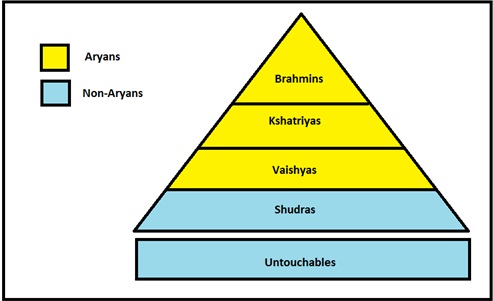
A simple chart of the caste system. Over time, society grew more complex and new specialists appeared, so each caste was divided into thousands of subcastes, for every conceivable job. For example, craftsmen had jeweler, goldsmith and silversmith subcastes. Sources: Wikimedia Commons and this paper.
The Aryans, like most peoples at this time, believed that many gods actively worked in the world around them. The Vedas list 33 gods and an unspecified number of goddesses. No god was considered king over the others, but at this early date the most popular was the god of war and storms, Indra, who is usually portrayed as a lusty warrior that enjoyed both fighting and feasting. Other important gods were Surya (the sun), Agni (fire, from which we get the word "ignite"), Varuna (law), and Rudra (archery and healing). As the Aryans pushed deeper into the jungles of the subcontinent, they also encountered, and eventually adopted, non-Aryan gods like Shiva, Ganesha (the elephant-headed god of wealth), and Krishna. Finally Brahma (creation) and Vishnu (life), two of the chief gods in modern Hinduism, were also worshipped, but they were not considered very important yet.
The central feature of the Vedic religion was sacrifice, which was usually done to obtain a favor from the god it was directed at. Usually sacrifices were done under the influence of a drink called soma; nobody today knows what soma was made of, but it was a powerful hallucinogen that made the drinker think he was tougher than the world. The most common practice was to burn the offering, so that Agni could deliver it to the appropriate god in Heaven. Other methods were also used. The most unusual was a horse sacrifice called the Ashvamedha. A white stallion was released to wander freely for a year before it was recaptured and sacrificed. During its year of wandering a detachment of warriors followed it. The king claimed every place visited by the horse; if another king or chief owned the territory he had to submit or fight. Many petty wars started because of this custom. Others were started by cattle rustling; the Rig Veda's word for conflict translates as "search for cattle."
At first the sacrifices were simple procedures that any good Aryan could perform, but as the Brahmans grew rich and powerful they took over the rites, surrounding them with magic rituals so elaborate that only a trained Brahman could do them right. Any mistake in the ritual could destroy the patron. The priests demanded payment in cattle and gold for their services, and they charged a steep price; one text mentions a fee of 1,000 cows. Because they were so busy handling affairs of religion and culture, they handed over political duties to the Kshatriya caste, beginning the split between spiritual and secular life that has marked India ever since. And when the caste system grew rigid, Shudras and untouchables were not allowed to even watch the rituals.
The latter half of the Vedic Age, about 900 to 600 B.C., was a time that changed almost every aspect of Aryan life. The migration of footloose Aryans and displaced Harappans into the great Ganges valley sparked this. Iron tools and the plow were invented during this time; the Rig Veda does not mention them. Because the climate of the Ganges was wetter than that of the Punjab and the Indus valley, new crops (rice, millet and barley) replaced barley as the staple. The Ganges was very fertile, but it also required enormous labor to tame. Under these conditions, the newcomers settled down, and agriculture replaced livestock herding as the main livelihood. The indigenous peoples of the Ganges and surrounding areas, who had previously been hunter-gatherers, learned both agriculture and herding from the newcomers, and learned to speak Sanskrit. A tighter, more centralized government evolved, and tribes stabilized into kingdoms. Population increased rapidly, and cities appeared towards the end of this period, but a common heritage did not keep these states from feuding constantly and absorbing their weaker neighbors. One major war between two rival factions was written down as an epic called the Mahabharata; at 100,000 stanzas, about fifteen times the length of the Bible, it is the longest poem ever written.
As society changed, new literature developed, and with it Hinduism evolved into the form which now exists today. The first new text, the Brahmanas, was a series of commentaries on the Rig Veda that explained and justified the complex religion the Brahmans had produced. After that came epics like the aforementioned Mahabharata and the Ramayana (the story of Rama, one of Hinduism's most popular heroes). The most beloved of Hindu scriptures, the Bhagavad Gita, was also composed at this time, and later inserted into the Mahabharata.
Most useful to us are the Uphanishads ("Meditations"), a series of 108 scriptures produced by individual Brahmans who had withdrawn from the world in a quest for ultimate truth and knowledge. A common feature of this period was the number of religious thinkers who became hermits because they were disenchanted with Vedic ritual and the growing materialism of everyday life. They invented the practice of yoga and a key doctrine, reincarnation. Originally the Aryans had pictured the afterlife as composed of a carefree Heaven called the "World of the Fathers," and an unhappy place for sinners called the "House of Clay." Now in its place came the belief that man must live many lives until he reached a state of perfection that allowed him to become part of the gods. The collective deeds (karma) performed in each life determined the form a person would assume in the next life (they expected a real scoundrel to come back as a bug!). Those of the lower castes found this belief comforting because it meant that proper behavior (dharma) could allow them to be reborn as Brahmans. Vegetarianism became a logical application of this doctrine; no one wanted to eat meat or wear leather out of fear that it might come from somebody they knew!(8) Asceticism, meaning the denial of the pleasures of the material world, was seen as the best way to achieve righteousness and it was practiced by those who wanted to break out of the cycle of rebirths as soon as possible.
Later Hinduism found a place for the ascetics by declaring their practices acceptable provided they had (1.) studied the Vedas under the guidance of a guru (teacher) for ten to twelve years, and had (2.) already married and raised their children to adulthood, freeing them from their earthly responsibilities. Always a flexible creed, Hinduism added the teachings of the ascetics to its own, declaring that there were many ways to enlightenment, each suited to a different temperament.
By the sixth century B.C., the once supremely confident Aryans had turned into what we might call a national neurotic case: a whole race of pessimists that had come to think that life and the universe would never get any better than it was now. Instead of sacrificing to get something they wanted, they were now supposed to give up wanting. It became pointless to take pity on the sick, the poor and the untouchables; unfortunate people were seen as paying for the bad karma they got in the last life. They now saw the endless cycle of deaths and rebirths as depressing. The result was many middle and upper-class folks experimenting with new philosophies and seeking a better way of life.
Since so many people were looking for enlightenment, one would expect somebody to stumble across an answer. Two ascetics that did started teaching doctrines so radically different from Hinduism that they became new religions in their own right. One was Mahavira (540-468 B.C.), the founder of Jainism; the other was Siddhartha Gautama (563-483 B.C.), better known to us as the Buddha. Jainism would never become popular outside India, but Buddhism would find powerful patrons that would spread its teachings extensively until it became the most important religion of the Far East.
The Man Who Woke Up
Siddhartha Gautama was born to a minor raja in the foothills of the Himalayas. According to the legends that have grown up around the facts, he was a promising son from the start. Before his birth a wise man predicted that if he kept his mind on worldly matters, he would grow up to become the world's greatest king, but if he saw the real misery of the world, he would become the world's greatest teacher instead. Siddhartha's father definitely wanted him to become a king, so he sheltered the child from all sickness and decay, surrounding him with youth and beauty constantly.
As Siddhartha grew to manhood, it seemed that his father got his wish. When he was not in school learning the skills of war or the traditions of his culture, he went on tiger hunts. Back in the palace were more delights: a garden full of mango trees, and a sizeable harem that would be his on the day he became raja. Before long he also had a beautiful wife named Yasodhara. However, not long after the wedding came four incidents that would change the prince's life completely.
According to legend, Siddhartha was riding with his charioteer, Channa, in the sheltered precinct, and he discovered a gnarled old man whom the guards had somehow overlooked. Siddhartha asked Channa what that creature was and learned that people grow old. Not long afterward, on another ride, the prince saw a man covered with sores and shivering with fever, and learned that people get sick. The third sign he saw, a corpse being carried to the cremation ground, taught him that people die. But the fourth sign gave the unhappy prince hope; he saw a cheerful holy man who had nothing but a yellow robe and a bowl for begging. With that he knew what he had to do to find real peace in the world.
The palace was no longer a pleasant place for him; the next time he went to his father's harem, he saw the kingdom's most beautiful women as they would one day appear, with grey hair and wrinkles. Soon after, his wife gave birth to a son, but he felt no pride. That night, he said goodbye to them while they slept and rode away in his chariot with Channa. When they were well beyond the palace grounds, he got out of the chariot, removed his clothes and cut off all his hair, and said goodbye to Channa as well. Now that he was separated from everything that had ever belonged to him, he was ready to begin a new life.
The young ex-prince began his quest by learning about the Uphanishads from a guru he met. That failed to satisfy him, so he went with five other seekers into the forest to practice the most extreme asceticism possible. Siddhartha outdid them all, eating only one grain of rice a day, and continuing this discipline until he could feel his spine whenever he rubbed his stomach. Yet self-torture did not teach him the meaning of life, so after five years he gave up and went to a village to beg for food. His companions were appalled to see him eating and drinking again with enjoyment. They called him a reprobate and left him.
Siddhartha, now 35 years old, wandered to the kingdom of Magadha, and there he sat under a great tree that is now called the Bodhi (tree of wisdom). For seven weeks he stayed there, vowing not to move until he discovered the cure for suffering. After rejecting the evil spirits that offered him greater powers and pleasures than the ones he enjoyed as a youth, he descended into a trance that was somewhere between life and death, a perfect realm he would call Nirvana. When he woke up he became the Buddha, meaning the Enlightened One. Afterwards, as he tried to explain to others what had happened to him, he met again the five ascetics who had spurned him. They sensed at once the change that had come over him, and to them the Buddha preached his first sermon.
The Buddha's message was that there are four absolute truths: suffering is inevitable in this life, desire is the cause of suffering, suffering ends when desire is forsaken, and that the cure for desire is the Eightfold Path. The Eightfold Path, simply put, is eight rules to live by:
1. Hold the right views.
2. Have the right aspirations.
3. Use the right speech.
4. Show the right conduct.
5. Pursue the right livelihood.
6. Expend the right effort.
7. Maintain the right attitude.
8. Practice the right meditation.
The Buddha believed in the doctrine of karma, but his goal was not to get ahead in the next life. To him, the ultimate goal of following the Eightfold Path was to get to Nirvana, which literally meant "the blowing out," as of a candle. By reaching Nirvana, one could escape the whole sorrowful cycle of human existence through oblivion.
As the Buddha grew older, he gained many followers who strove to live by his example. He also gained the attention of Bimbisara (543-491), Magadha's first important king. According to one tale, the Buddha was visiting Bimbisara when a priest approached the king and told him to sacrifice fifty of his finest goats, assuring him that if he did so, both his prayers and offerings would go "directly to Heaven." The Buddha asked the priest if his father was still alive. The priest answered that he was, and the Buddha inquired, "Then why not sacrifice him?" Delighted, Bimbisara kept the goats and banished the priest. With the traditional power of the Brahmans broken, the kingdom of Magadha had made an important step toward becoming an empire. It would be nearly three centuries before a Magadhan king converted to Buddhism, but their tolerance of the new creed allowed its fortunes to grow along with their own.
The Straighest, Narrowest Path
The yellow-robed followers of the Buddha were not the only Indians who rejected the teachings of their ancestors. At the same time a second group of mystics wandered the countryside "sky-clad," meaning stark naked. They called themselves Jains, meaning "conquerors," and they called their leader Mahavira, the "Great Hero." Like the Buddha, Mahavira was a prince (originally named Vardhamana) who had renounced his exalted status to become a wandering ascetic. He first joined a group of religious nudists called nigranthas ("free from bonds"), staying with them for ten years until their leader died. He then left with a group of followers from the sect and in his thirteenth year of searching he experienced the revelation that showed him what to teach others.
Mahavira believed that the soul consists of tiny particles called jiva, which can be found in every living thing: people, animals, even flies and worms. Humans were caught in the cycle of reincarnation because every good or bad deed committed in a lifetime attaches itself to the soul. Unfortunately, the soul is weighed down and prevented from escaping this universe because in an ordinary life bad deeds attach to it faster than they can be removed. The only answer is to practice a self-discipline so strict that it will burn up all accumulated bad karma and reduce the influx of new bad karma. The greatest evil is the destruction of life, and Jains will go to any extreme to keep from doing it. They only walk in daylight to avoid accidentally stepping on any of the soul-laden animals around them, carry dusters to whisk away insects from where they sit(9), and ask the permission of the grass before they walk across it. Jains do not practice agriculture because it is too damaging to life, so most of them become merchants. Eating meat is strictly forbidden, and Mahavira admitted that even the eating of vegetables was a necessary evil. Because of this, he showed little interest in maintaining his own life; at the age of 72 he practiced the ultimate self-discipline by starving himself to death.(10)
Jainism has undergone no fundamental changes since Mahavira's time; its followers, though, have stopped the practice of public nudity to avoid offending potential converts. Salvation in this life may be possible for any Jain, but it is only a sure thing for Jain monks, who renounce all property and sex along with the ways of violence. Jainism has no gods of its own (Mahavira never bothered mentioning them), so in practice pictures of Mahavira and Hindu deities are venerated.
Jainism has always had a very limited appeal, because its disciplines are too strict for most people. Another turnoff is the Jain attitude toward charity; good deeds and acts of kindness are considered pointless, and even harmful to one's soul, if they are done with the expectation of something in return. There are three and a half million Jains in India today, but almost a hundred times as many Buddhists can be found all over Asia.
The Rise of Magadha
When the curtain of history rose again in the sixth century B.C. there were sixteen states, called the Mahajanapadas, and several smaller communities in the northern third of the subcontinent. Some of these states were fully developed monarchies; others were republics made up of one or more tribes. The four strongest states--Kasi, Kosala, Magadha and Vrjji--were all along the Ganges River. Of those four, Magadha had several advantages that would help it to prevail in the struggle for supremacy. First, it was blessed with rich farmland and forests. Access to the Ganges brought commerce and profits. Able kings who were willing to try new ideas governed it, the first being the previously mentioned Bimbisara. Above all, rich deposits of iron ore gave Magadha a lead in technology.
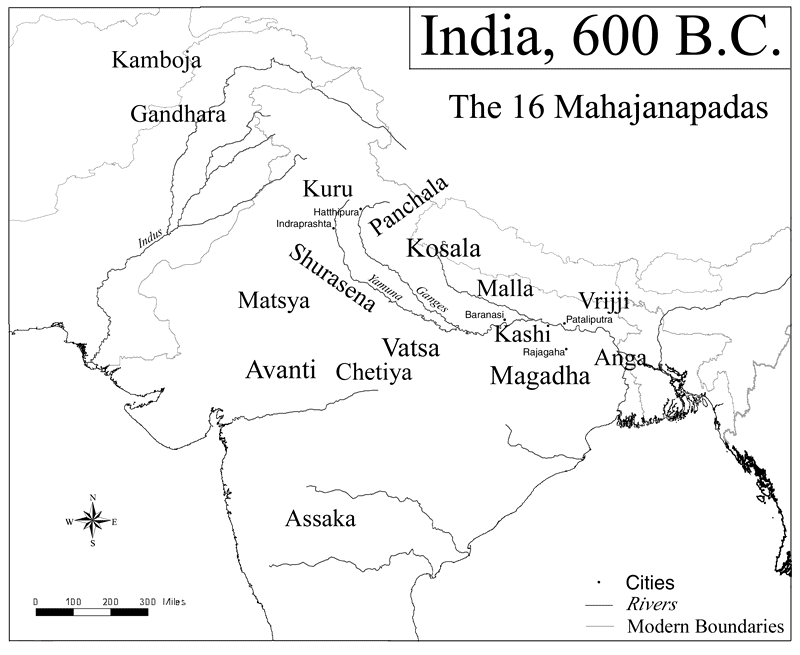
The road to greatness for Magadha began when Bimbisara conquered a secondary state called Anga, in the Ganges Delta. This gave Magadha a seacoast and allowed it to send merchant ships into the Bay of Bengal. At home Bimbisara overhauled the tax code, making his government the most efficient in all of India. His son Ajatasatru (491-459 B.C.) conquered Kasi, Kosala and Vrjji, giving Magadha control over the entire Ganges valley. After his reign ended two less effective dynasties ruled, first the Sisunagas and later the Nandas. Magadha maintained its preeminent status, but there was no more expansion for the next 140 years.
Meanwhile, contacts with the West gradually increased, but they were limited to trade until Media/Persia expanded into Afghanistan and Baluchistan.(11). In 518 B.C. (or 513?) the Persian king Darius I advanced to the Indus River, annexing the kingdoms there. For over a century the Indus valley was the twentieth and easternmost satrapy (province) of the Persian Empire. The rest of India was unconquered, but the Indians learned the use of money and writing(12) from the Persians during this time. As the Persians grew weak in the fourth century, a local ruler named Porus declared independence (338? B.C.). The Persians were unable to regain control before Alexander the Great conquered their empire.
Pursuing his campaign to the farthest frontier of Persia, Alexander entered India in 327 B.C. It took him nearly a year to force his way through the mountain passes of Afghanistan (the weariness of nearly a decade of fighting was starting to show). After he got through there was a pitched battle with King Porus on the banks of the Hydaspes (Jhelum) River, a tributary of the Indus. Porus had a force of twenty thousand infantry, two thousand cavalry, and 200 war elephants, to repel the invader. Instead of waiting for Porus to come to him, Alexander took the initiative, leading his army across the river under cover of a thunderstorm. The battle was an awful slaughter for both sides, until the elephants panicked, trampling the Indians in their stampede. Porus surrendered, and Alexander asked him how he wanted to be treated. "Like a king," Porus replied. In admiration of a gallant opponent, Alexander restored him to his throne and made him governor over his Indian provinces.

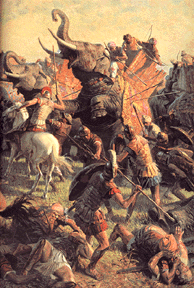
Two pictures of Greek soldiers and elephants, at the battle of the Hydaspes.
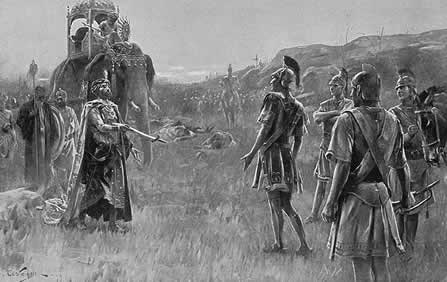
Alexander accepts the surrender of Porus.
Alexander's favorite horse, Bucephalus, died in the battle, so in his honor a city named Bucephala was founded on the spot. Then Alexander marched into the Punjab. Traveling with him at this point was a teenager named Chandragupta Maurya (Sandracottos in Greek biographies of Alexander). Chandragupta had been exiled for some reason by the current king of Magadha, Dhana Nanda, and went off seeking his fortune until he joined the Greeks. As for Alexander, he was curious about the land he had entered, with its strange animals, rubies and gold, steaming jungles and dusty plains, the farthest place known to the Western world. Beyond the Ganges--or so everybody believed--was the encircling ocean that marked the end of the world. Alexander was determined to wet his feet in it. Chandragupta urged Alexander to go on, confident that the Macedonian army could defeat Dhana Nanda.
The troops had other ideas.(13) The battle with Porus was bad enough, and rumors came to them of even stronger armies awaiting them in the east. After marching 200 miles, they stopped and refused to go any farther. Alexander took to his tent. When he emerged three days later and announced they were going home, the troops rejoiced. "Alexander," they said, "has allowed us, but no other, to defeat him."(14)
The Mauryan Empire
While Alexander's army marched down the Indus and west across the Baluchistan desert, Chandragupta chose to stay where he was and try what he learned about empire-building. Somehow with the help of a cunning teacher named Chanakya (371-283, called Kautilya in older texts), he raised an army and led a revolt against the king of Magadha. Chandragupta claimed that Dhana Nanda was unfit to rule Magadha because the Nandas were really of lowly origins; the founder of the Nanda dynasty was the son of a barber, a member of the Shudra caste. We saw previously that Shudras were only expected to be servants, so Chandragupta asserted that even a poor Kshatriya like himself would be a better ruler than a wealthy Shudra. The propaganda worked; Chandragupta wore down the army sent against him, and overthrew the last Nanda monarch in 321 B.C. Then he enlarged his army until it had at least 400,000 men, and embarked on vigorous campaigns of conquest against the small states around his growing realm, culminating with the seizure of the Indus valley in 305 B.C., which had been weakly held by one of Alexander's successors, Seleucus Nicator. Seleucus recognized the loss of this territory to a superior rival in a treaty that gave the Indus valley and his daughter in exchange for 500 elephants.(15) At home Chandragupta's capital, Pataliputra, was greatly enriched, and run by a bureaucracy that was both enormous and efficient. As prime minister, Chanakya ran the bureaucracy, where he proved to be more a Machiavellian schemer than Machiavelli himself. Like that famous Italian, Chanakya wrote a book on government which still exists, called the Arthashastra ("The Science of Material Gain").
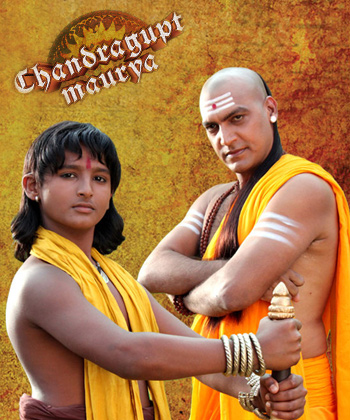
More than 2,300 years later, in present-day India, Chandragupta Maurya got his own TV show; it ran for 105 episodes. Chanakya is on the right.
Virtually every aspect of an individual's behavior was considered a proper area for state control. Chanakya believed that because men are fickle and temperamental, they should be allowed neither dispute nor unity, since disputes hindered work and unity threatened the state. To maintain this control he kept spies everywhere, both women and men; in fact he had so many spies that they became a new class in society. Many were trained in childhood for the profession, and some were assigned to spy on other spies.
Though Chandragupta's reign was a classic example of enlightened despotism, it ended on a strange note; growing more religious as his successes piled up, Chandragupta abdicated, became a Jain monk, and achieved the Jain equivalent of bliss by starving himself to death! His son Bindusara (297-272) continued his father's conquests by invading the Deccan plateau. By the time he was done the only states left unconquered were Kalinga (modern Orissa) and three in the southernmost tip of the subcontinent: Chola, Pandya, and Kerala. We also know that he followed Ajivika, an obscure sect that split off from Hinduism around the same time that Jainism and Buddhism did, but no longer exists today. But that is all we know about Bindusara; he did not leave as many records as Chandragupta and the next king, Asoka. Because Chanakya served Chandragupta so well, Bindusara kept him in the prime minister's post; he helped centralize the nation by deposing local princes, from the former Mahajanapadas. When Bindusara died a vicious struggle for the throne began among his sons; it ended in 268 when Asoka slew all but one of his brothers.
Originally Asoka was as ruthless a ruler as his two predecessors. Eight years after he took over, he invaded and conquered the kingdom of Kalinga. More than 100,000 people were killed in that campaign. Asoka was so disgusted at the carnage that he became a Buddhist and vowed never to start another war. The rest of Asoka's enlightened reign was devoted to improving the lives of all his subjects, making the Mauryan Empire the first welfare state in history. He disbanded the corps of spies and rejected the cynical advice of the Arthashastra; in its place Asoka called the Indian people "my children," and worked to give them "every kind of welfare and happiness both in this world and the next." Hospitals and veterinary clinics were set up, subsidized by the government--the first state health care system. For the local infrastructure, roads, inns and monasteries were built. Finally, to promote both peace and Buddhism, animal sacrifice was outlawed. All over the empire Asoka set up rock edicts, pillars inscribed with his words of wisdom. Beyond the empire's borders he sent missionaries, spreading Buddhism and modern civilization to the south Indian states, the Maldive Islands, Sri Lanka(16) and Southeast Asia. Indian ambassadors/missionaries even went to the Greek kingdoms in the west, though few converts were made there.
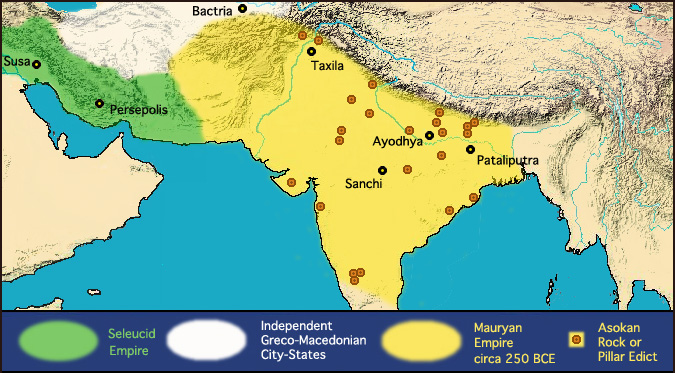
Asoka's empire.
Asoka had turned the Mauryan Empire into a utopian society, and this system, with its commitment to pacifism, could only work as long as its leaders had a vision to continue it that way. Instead, most people in positions of power remembered that more than sixty years of war, not pacifism, was what had created the empire in the first place. When Asoka died, his sons struggled bitterly for the right to succeed him, and the empire fell to pieces. By 184 B.C. the last king claiming to be the Mauryan emperor was gone, assassinated in the middle of a military parade by the army's Brahman commander. Now a new age of chaos began. There is, as a rule, only one Asoka to a dynasty.
Invasions and Influence from the Northwest
After the treaty of 305 B.C., the Mauryan Empire got along fine with the Greeks, in part because the Greeks were too preoccupied with affairs in the west to pay attention to their eastern frontier. Then in the middle of the third century B.C. a new group of nomads, the Parthians, marched from Central Asia to Iran and set up their own kingdom. Simultaneously Diodotus, the Greek governor of Bactria (Afghanistan), declared his province independent. A later Bactrian king, Demetrius (190-167), took his armies into the Punjab, gaining control over northwest India. The result was a mingling of Indian and Greek culture, now known as the Gandhara school of art (Gandhara was the main city in the northwest at this time). For the next 500 years Indian sculptors would carve images of the Buddha in the Greek style, with big muscles and a Greco-Roman toga. The Greeks also introduced what they knew about astrology and medicine, and the Greek theater probably influenced Sanskrit drama. The cultural winds could also blow the other way; one of the last Bactrian kings, Menander (155-130), converted to Buddhism.
Bactria was destroyed in 130 B.C. by the Scythians (called Sakas by the Indians). The Sakas had been pushed out of their Central Asian homeland by yet another tribe, the Yuezhi (also called the Tocharians), which had in turn been expelled from northwest China by the Xiongnu (Huns). Taking advantage of a momentary weakness in the Parthian Empire, the Sakas pushed into northwest India and eastern Iran. Around 80 B.C. the Parthians regained control of their lands; a Parthian family called the Surens was put in charge of eastern Iran, which now had so many Sakas in it that they called it Sakastan (modern Seistan). Like the Soviet satellites of the twentieth century, the Suren kingdom was officially independent, but it always toed the Parthian line. In 18 A.D. they advanced to the Indus River, driving the anti-Parthian Sakas deeper into the subcontinent. The Parthians themselves never invaded India, but they seem to have been quite content to rule part of it via satellite. Another puppet Saka state, the Kshatrapas, ruled the Gujarat peninsula and surrounding areas from 110 to 395 A.D. Before the Parthians disappeared they brought, according to legend, the Apostle Thomas, who introduced Christianity to India before dying in the south near Madras.
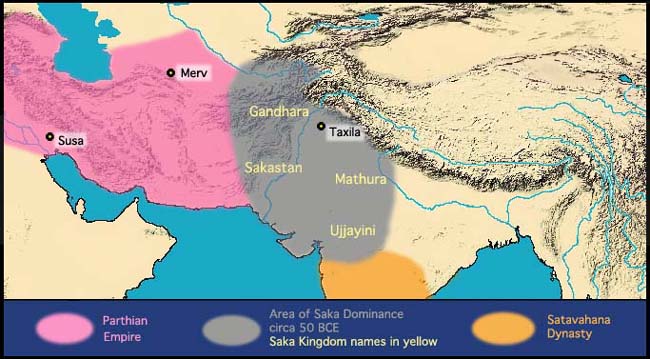
The Saka intrusion.
In central India, the most important state was that of the Satavahanas, based in modern-day Maharashtra and Madhya Pradesh. This dynasty had been a vassal to the Mauryan kings Bindusara and Asoka, but declared independence soon after Asoka's death (230 B.C.). For India they were a source of stability, defeating attacks from the Sakas, Yavanas (the Sanskrit name for the Greeks), and the Pallavas (the most powerful kingdom in south India). They also led the way among the Indian states, when it came to colonizing and trading with Southeast Asia. Around 220 A.D., the Satavahanas split into several smaller states.
In the first century A.D. the Yuezhi broke camp and started south again. They destroyed the Suren kingdom (60 A.D.), settled down on the upper part of the Indus, changed their name to the Kushanas, and founded an empire named Kushan, which grew to encompass Central Asia, Afghanistan, Pakistan, and even the upper half of the Ganges. Under its greatest king, Kanishka (78-102 A.D.?--all of Kushan's dates are uncertain), Kushan's rule stretched from the Caspian Sea to Khotan in northwest China, and as far east as Benares in India. Kushan's capital, Purushapura (modern Peshawar), became a center for commerce and religion. The Silk Road, the great trade route between China and the Roman Empire, passed through the northern part of the realm, allowing Kushan to make a profitfrom the traffic on it; Kushana merchants could also sail down the Indus to the Arabian Sea, selling their wares as far west as Egypt. Romans, Parthians, Indians and Chinese could all be found in Kushan, pausing here as they traveled from one country to another. On top of all that, Kanishka was a great patron of Buddhism; in his reign it was both reformed and introduced to China.
For a long time, perhaps as far back as the reign of Asoka, Buddhists had argued over how they should teach their creed. Some believed that it was asking too much to make everyone get to Nirvana on his own. Their solution was to introduce the idea of the Bodhisattva, a saint who has achieved the ethical perfection needed to enter Nirvana, but has instead chosen to stay on earth and save as many ordinary people as possible. Under Kanishka's leadership, the revisionists held a council in Kashmir, where over a six month period they hammered out an elaborate theology to explain what they believed. They called their doctrine Mahayana, meaning "Greater Vehicle," because as they saw it, "Why should salvation be portrayed as a small raft that can only carry a few, when it is really a big ship with space for everyone?" The Buddhist fellowship in Sri Lanka boycotted the Kashmir council and promoted a conservative doctrine that they called Therevada, "The Way of the Elders"; Mahayanists called it Hinayana, the "Lesser Vehicle."
Two more differing creeds that claim to be the same religion would be hard to find. The only thing they have in common is observance of the Buddha's four truths and the Eightfold Path. The differences between modern Mahayana and Therevada Buddhism are summarized below:
1. View of God and the Afterlife: Therevadists say that God, if he exists, is irrelevant--as a being of the universe He (She? It?) is subject to the same law of Karma as humanity. Mahayanists on the other hand teach that piety is a virtue, and their sect readily combines with other religions. Often a vision of Heaven and Hell comes in this way, replacing the Buddha's formless Nirvana.
2. Man's Role: Therevada teaches that man is an individual, who must achieve salvation on his own. Mahayana teaches that man is not alone, and he is in this world to help others.
3. Ideals: Therevada's ideal is the arhat, a monk who steers for the goal of Nirvana without letting anything get in the way. The Mahayana ideal is the Bodhisattva, one who vows not to leave this world until "the grass itself be enlightened." Therevada's highest virtue is wisdom, Mahayana rates compassion as the most important quality to have.
4. Ritual: Therevada cares little for metaphysics and ritual; prayer is limited to meditation. Mahayana has a place for ritual and petitionary prayer.
Mahayana Buddhism is a greater vehicle in its geographical spread; today it is the most widely practiced religion in China, Tibet, Bhutan, Mongolia, South Korea, Japan and Vietnam. Therevada is found in a much smaller area: Sri Lanka, Burma, Thailand, Laos and Cambodia.
The Gupta Empire
The Kushan Empire was destroyed in 244 A.D. by Shapur I, the second king of the Sassanian or Neo-Persian Empire. Yet the Persians, like their Parthian predecessors, were too busy dealing with the Romans to occupy any Indian territory, and they left the lands on their eastern frontier full of Kushan city-states. Now the center of power in India shifted, from the Gandhara district of Pakistan back to the east. Here the Gupta dynasty brought stability for 147 years; under three outstanding and two good kings, India would experience a golden age.
While there is no evidence that the Mauryan and Gupta families were related, the similarities are astonishing: the first great king of each was named Chandragupta, and he ruled from Pataliputra! Another coincidence comes from the dates; we saw the Mauryans get started in 321 B.C., while the Guptas got started in 320 A.D.
The Guptas first appeared around 275 as very minor rulers; the dynasty's founder was one Sri Gupta, who owned a small fief on the border of present-day Bihar and West Bengal. Several historians have asserted that he came from the Vaishya caste, meaning he was probably a merchant who made good, and he broke the rules of the caste system by becoming the ruler of a state. Nevertheless, he bequeathed the state to his son Ghatotkacha (280?-320?), and it looks like the people forgot the dynasty's humble origins after that, for they gave Ghatotkacha the more honorable title of maharaja. He was in turn succeeded by his son Chandragupta I, who turned the state into an empire. The family got their lucky break in 305, when Ghatotkacha arranged a marriage between Chandragupta and Kumaradevi, a princess of the Licchavi clan, the current rulers of old Magadha. It appears that the Licchavis had no heir, because Chandragupta added Magadha to his own realm. The Gupta era officially began in 320, but it is uncertain whether that date marks the beginning of Chandragupta's reign, or the end of the Licchavi dynasty. Chandragupta signaled the new era by changing his title from maharaja to maharajadhiraja--king of kings.
When he died in 335, Chandragupta ruled a sizeable portion of the Ganges valley, equivalent to the modern states of Bihar and eastern Uttar Pradesh. He urged his son, Samudragupta, to "rule the world," and Samudragupta did his best to comply. First he put down revolts from rival contenders to the throne. Then calling himself the "Exterminator of Kings," he overthrew nine of them, expanding the boundaries of the kingdom in the process to include the rest of the Ganges and the Punjab. He also led a campaign down the east coast, going almost all the way to the subcontinent's southern tip, turning back at Kanchi, in Tamil Nadu state. On this campaign he made no permanent conquests, choosing instead to reduce all kingdoms east and south of his empire to vassalage, and establish relations with Sri Lanka and the islands of Southeast Asia. When he wasn't at war, Samudragupta patronized the arts, and showed off his artistic talents, making sure he would be remembered as a poet, musician and philanthropist as well as a soldier. In other words, imagine what Asoka would have been like, if he had not become a peaceful Buddhist.
Because Samudragupta was so successful, one British Historian, Vincent A. Smith, has called him the "Indian Napoleon" and remarked that he was "endowed with no ordinary powers." However, the empire seems to have suffered a hiccup after his reign, for his eldest son and heir, Ramagupta (375?-376), was not a capable ruler like the other Guptas. In fact, Ramagupta was so bad that an attempt was made to write him out of history; most texts go directly from Samudragupta to Chandragupta II without mentioning Ramagupta. What we do know comes from a play written about him, which reports that Ramagupta led an army into the Gujarat peninsula against one of the last Saka kings, Rudrasimha III. Instead, Ramagupta was defeated, and besieged in a hill fort; to get out, he agreed to terms of surrender that forced him to give up his beautiful queen, Dhruvadevi, to his opponent. As you might expect, the queen was outraged by this arrangement, and called on Ramagupta's younger brother, Chandragupta II, to save her. Because the Guptas weren't strong enough to use force alone, Chandragupta resorted to a trick; he disguised himself and several hundred soldiers as women, sneaked into the enemy camp and killed the Saka king. Afterwards Chandragupta became the next emperor and married Dhruvadevi; she became the mother of another emperor, Kumaragupta I (see below). What happened to Ramagupta was not reported, but it's a safe bet he did not live happily ever after.
Chandragupta II (376-415) is now remembered as the greatest Gupta ruler of all. He pushed west, finished off the Sakas, moved his capital to Ujjain (a Saka stronghold in central India), and conquered Gujarat. Now the empire had seaports on both the Bay of Bengal and the Arabian Sea. This brought the border up to a rival state; the Kingdom of the Vakatakas had ruled much of the western Deccan since the 250s. But Chandragupta had also learned from his predecessors that diplomacy pays. Instead of fighting, he arranged for his daughter Prabhavati to marry Rudrasena II, the Vakataka king. The result was better than an alliance; Rudrasena died young, and Prabhavati became regent over their children, allowing Changragupta to have a strong influence over the kingdom until the kids grew up. Thus, expansion of the empire stopped--not because of weakness or lack of will from the Guptas, but because it was no longer necessary--the empire had run out of enemies. All surrounding states recognized Gupta supremacy and paid tribute, or were at least friendly.
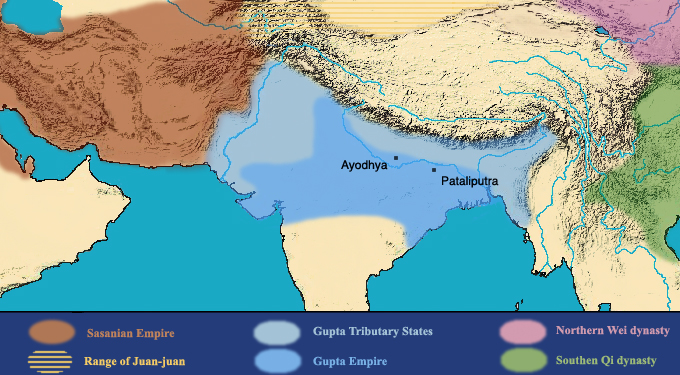
The Gupta Empire and its neighbors.
Chandragupta II devoted the rest of his reign to peaceful pursuits. As a result Indians now regard the Gupta era as a golden age. Though the Guptas were devout Hindus, they constructed places of worship for all three of India's religions (Hinduism, Buddhism and Jainism). Much of what we know about the Gupta Empire comes from the travel account of Faxian, a Chinese monk who made his pilgrimmage to India during Chandragupta II's reign. He reported that Buddhism was doing well, but it was Hinduism that prospered the most. Ever since the fall of Kushan, Buddhism's popularity in India had been on the decline, because the patronage of Asoka and Kanishka caused the common people of India to view it as a religion for the rich and powerful. Meanwhile the Brahmans went into the countryside, where they taught and converted the masses. Where local cults existed, the Brahmans absorbed them into mainstream Hinduism, declaring that such forms of worship were merely a different way of reaching the same goals they strived for. Many of Hinduism's sects, like the erotic mystery cults called Tantrism, got started this way. The Brahmans also tightened their hold on the faithful by writing the Dharma Shastras, a set of rules concerning how members of different castes should behave in every conceivable circumstance.
The Hindu renaissance sparked a wave of creativity. Scientists worked with sophisticated mathematical tools such as pi, negative numbers, and quadratic equations; they also invented the zero and decimal notation (what we call "Arabic numerals" were originally Indian). Aryabhata, an astronomer and mathematician, discovered that the earth is round, rotates on its axis, revolves around the sun, and that lunar eclipses were caused by earth's shadow falling on the moon. The first stone Hindu temples were built, replacing the caves and simple wood and brick structures that had been places of worship previously. In the field of literature, Sanskrit classics like the Mahabharata and the Ramayana were written down in their final form. Kalidasa, the greatest Indian poet and playwright, lived during the Gupta era, and Gupta writers composed the Kama Sutra, the world's most famous sex manual. Chandragupta II encouraged the development of Sanskrit verse by staging poetry contests. The poets responded with enthusiasm, developing a complex, ingenious style that used riddles, puns, double entendres, wordplay, obscure meanings--anything to win. And when all else failed, they were not above slipping the judges a bribe.(17)
One reason for the golden age was that the Persians were positioned nearby. Being aggressively Zoroastrian at this point, the Persians probably did not care much for the Indians or their religions, but they liked the current residents of Central Asia less. These were the White Huns (also called the Ephthalites or Hunas), a fearsome barbarian tribe related to Attila's Huns. As long as the Persians were strong enough to keep the White Huns away, the Guptas could enjoy peace and prosperity. Chandragupta's son and successor, Kumaragupta I (415-455), did just that for forty years. Nevertheless, during the reign of the next king, Skandagupta (455-467), the White Huns inflicted some critical defeats upon the Persians and broke through the barriers protecting India from them. They proved to be just as nasty as the Huns which helped bring down the Roman Empire; the White Hun equivalents of Attila were Toramana and Miharagula (also spelled Mihirakula).(18) Skandagupta was a great warrior, who put up a valiant defense, but by the time of his death warfare had drained the treasury and the end of the empire was in sight.
There appears to have been a struggle for the throne at the same time, because Skandagupta was the son of a concubine, not the previous queen, meaning he was illegitimate. He was succeeded by a half-brother, Purugupta (467-473), who was a weak ruler, and so were all the kings that followed. Genealogies of the kings after Skandagupta disagree considerably, so our guess is that the empire was already in pieces by this time. The White Huns spent the first half of the sixth century removing these Gupta monarchs one by one.
Meanwhile to the southwest, the Vakatakas made their cultural contribution. Like the Guptas, they used art and architecture to promote religion. In a cliff at Ajanta, in Maharashtra State, they carved out caves to use as Buddhist temples and monasteries. There are twenty-nine caves in all; the oldest date to the second and first centuries B.C., but most of them are the work of Harishena, the greatest Vakataka king (ca. 475-500). When he wasn't expanding the kingdom to its maximum extent (see below), he patronized and promoted Buddhism here. Nearly every wall in the caves is covered with murals depicting scenes from Buddhist scripture and from the Vakataka court. These are the best examples of Indian painting before the Mogul era (see Chapter 3), and the Ajanta caves have rightly been a UNESCO World Heritage Site since 1983.
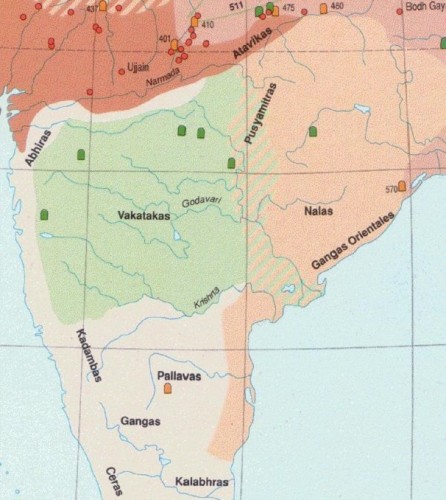
The Vakataka kingdom in the late fifth century.
Suddenly, work on the Ajanta caves stopped. It ended so abruptly that some of the painting and carving was left unfinished, and the caves were soon abandoned (they would be re-discovered by a British tiger hunter in 1819). We know why this happened; the patron was gone. The kingdom's location meant it took longer for the White Huns to get there, and they left the Vakatakas alone while they were looting the Guptas, but they did show up eventually. By the time they arrived, Harishena was dead, and his incompetent successors were no match for the raiders, or for the minor kings who revolted against Vakataka rule. The kingdom quickly collapsed against these internal and external assaults. Again India was congested with petty, quarrelsome states, and it remained that way even after the White Huns had been destroyed by the Turks and the Persians.(19)
This is the End of Chapter 1.

FOOTNOTES

1. The main ethnic groups to come in were Indo-Iranians, Greeks, Scythians, Huns, Arabs, Turks, and Mongols.
2. This place was also the setting for Rudyard Kipling's The Jungle Book.
3. The Hindi word for "tomorrow" is the same as "yesterday."
4. Before the invention of money (between 700 and 500 B.C. in the Middle East), all economic transactions were done by barter. Under this system, the granaries of Harappan cities would have doubled as banks; no wonder the rulers kept the granaries near them.
5. Don't give up hope. There is a chance that someday we will find a clay tablet with both cuneiform and the Indus script on it, because the Sumerians evidently understood both. One of the last Sumerian kings, Shulgi (about 1882-1835 B.C.), claimed he could speak five languages, and one was the language of the "men from the black mountains," a reference to Meluhha (see the next footnote).
6. A minority opinion asserts that Meluhha was in Africa, because when the Assyrian king Ashurbanipal (669-627 B.C.) mentioned Meluhha centuries later, he was clearly talking about Nubia (modern Sudan). However, Nubia does not have timber or carnelian. My guess is that timber was India's most important export to the west, because Iraq did not have good quality wood.
India was the first place to grow cotton--it was grown even at Mehrgarh--but we don't hear of cotton being exported to the Persian Gulf before the Assyrian era (after 900 B.C.). The Indus valley cities also had rice and chickens, which came from Southeast Asia originally, and were also introduced to the west later on. The oldest representation of a chicken in Indian art was a rooster on some of the Harappan seals, and because cockfighting is an ancient sport in much of Asia, this leads us to wonder if Indians raised them for fighting before they raised them for eating!
7. The Aryans eventually adopted this custom, though. Today wherever Shiva, the god of destruction, is worshipped, the phallus--called the linga or lingam--is one of his emblems, symbolizing that he has the power to both create and destroy.
8. It was about this time that the Aryan form of wealth, cows, became sacred. Ever since that time cows have been seen as an example of how to live peacefully. It is ironic that today's militant Hindus often use the phrase "cow protection" to justify acts of violence against Moslems!
9. According to one very modern-sounding Indian myth, one day all the animals held a meeting to decide what to do about human beings. The vote was near-unanimous: humanity is a threat to nature and must be destroyed. Only the mosquito spoke up for us; she liked people because they are so delicious! As a result, mankind was spared, and today grateful Hindus and Jains always think twice before swatting a mosquito.
10. The Buddha, by contrast, taught a more moderate doctrine and died moderately; at the age of eighty he overdosed on a meal of spoiled pork.
11. We used to believe that all contact between India and the Middle East stopped during the Vedic Era, but now it appears that trade continued, at least on a small scale. When Egyptian embalmers mummified the great pharaoh Ramses II, they stuffed his nose with peppercorns, to preserve the nose's shape during wrapping. And recently small flasks containing cinnamon, dated to 1000 B.C., were discovered in Israel; King Solomon must have liked spices. In both cases the spice was the Asian variety, not the kind that comes from Africa, and the nearest source of pepper and cinnamon in Asia was south India. We also read in the Old Testament about Solomon sending merchants to get him "ivory, apes and peacocks" (1 Kings 10:22 and 2 Chronicles 9:21), and India was a good source for all three luxuries.
12. The Indians developed two alphabets, both derived from the Aramaic that was so widely used in the Middle East at this time. The older of the two scripts, Brahmi, was invented between 800 and 600 B.C. by the merchants who reestablished the trade route; it became the alphabet of Sanskrit, and later evolved into the alphabets of modern Indian languages. The other script, Kharoshthi, was introduced after the Persians conquered the Indus valley; it wasn't as popular, presumably because it used 252 different letters.
13. I agree with the troops. Because of the high population of the Ganges valley, and because the Greeks were thousands of miles from home, I believe that if Alexander had gone on to the Ganges, he would have suffered his first defeat. According to Plutarch, Magadha under the Nanda dynasty had 200,000 infantry, 80,000 cavalry, 8,000 chariots, and 7,000 war elephants. For the Greeks, fighting that would have been like fighting a second Persian Empire. And when the kingdom of Magadha became the Mauryan Empire, a few years later, it had at least 20 million people, making it the world's most populous state in the fourth century B.C. By contrast, we estimate there were no more than 4 million Greeks at this time, despite all their accomplishments. China doesn't count because this was the "Age of Warring States," when China was divided into a bunch of petty kingdoms, each of them smaller than Magadha. Chinese unification would come a century after Alexander, under the Qin dynasty.
14. After the previous sections on Indian holy men, you may be wondering if Alexander the Great met any holy men, while he was in India. Well, yes; his army met a group of holy men at the city of Taxila. Alexander found these gurus so interesting that he wanted one of them to come with the army, when he returned home. A series of negotiations followed, and then an individual that Greek authors called Kalanos or Calanus (we don't know his Indian name) joined Alexander's entourage.
Unfortunately for Alexander, Kalanos was an old man in his seventies, and the journey he went on was too rough for him, especially the march through the Baluchistan desert. Because of that, and the changes in weather he endured, he was sick by the time the army reached the city of Susa, a former capital of the Persian Empire. Rather than succumb to a lingering illness, Kalanos decided the time and place for his death. Alexander tried to talk him out of committing suicide, and when he couldn't do it, he ordered one of his generals, Ptolemy, to build a funeral pyre, and because Kalanos could no longer walk, he was carried to the pyre on a litter. Eyewitnesses to this self-immolation reported that Kalanos did not flinch as the flames of the pyre touched his body and consumed him. Afterwards, Alexander drowned his sorrows by holding a drinking contest, in which forty-two contestants, including the winner, died of alcoholic poisoning.
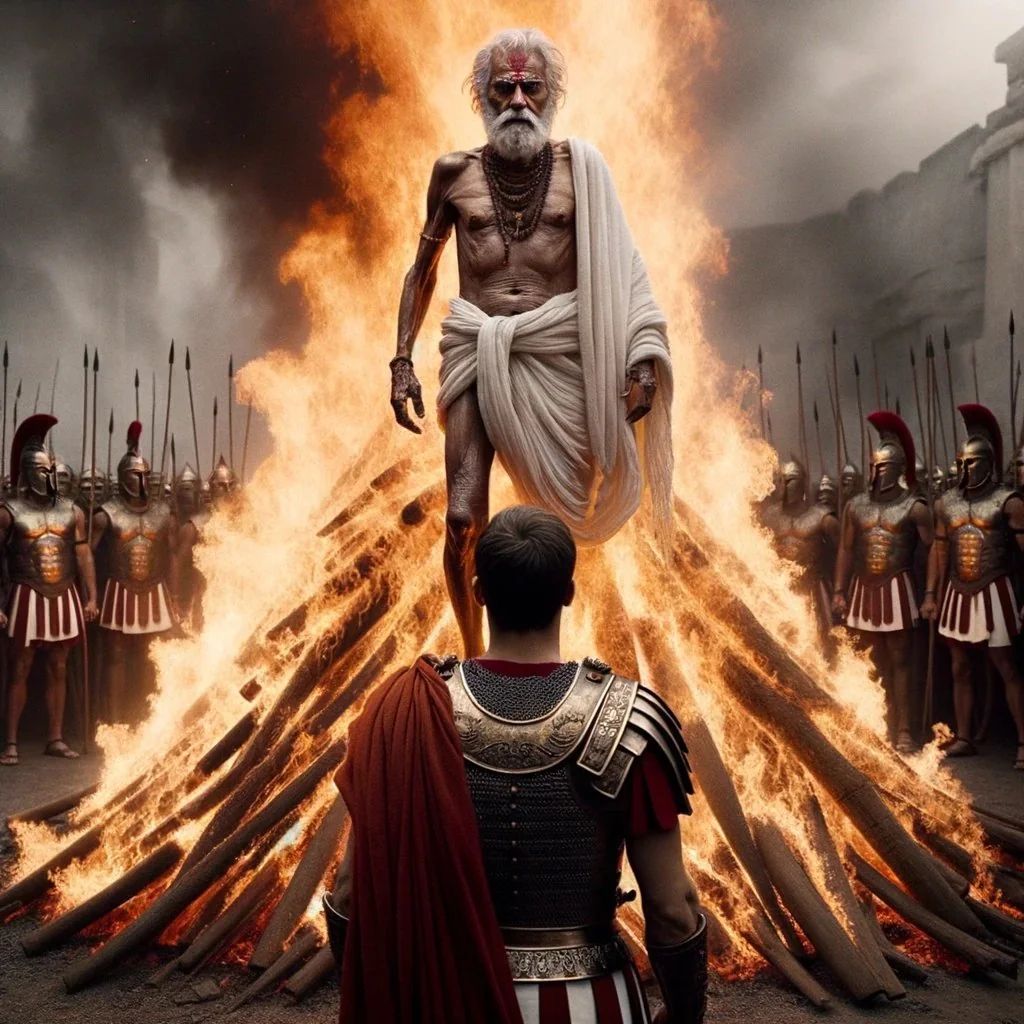
The death of Kalanos, as Ptolemy watches.
In case you didn't find that story creepy enough, one version of the story is even creepier. Supposedly, before the pyre was lit, Alexander asked Kalanos if he had any last words, and Kalanos said, "We shall meet in Babylon." Sure enough, Alexander died after he reached Babylon, in the following year (323 B.C.).
15. Much of what we know about Chandragupta was written down by Megasthenes, the ambassador of Seleucus. Megasthenes reported that Chandragupta's bodyguards were 500-700 female warriors, as if he was a real-life supervillain. Some of the webpages I stumbled upon went further, claiming that Chandragupta gave military training to the daughter of Seleucus and her ladies-in-waiting, and enrolled them in his Amazon bodyguard. I could not verify if this was true, but knowing how most Greek men believed in keeping their women barefoot and pregnant, it would have been a more interesting life for the women, than if they had stayed home in Greece.
16. Sri Lanka was called Ceylon before 1971 A.D.
It took until the fourth century A.D. for Buddhism to become the main religion of the Maldive Islands. In the 1980s, the government of the Maldives invited the adventurer Thor Heyerdahl to excavate some ruins on their atolls. For this expedition, unlike those which made him famous, Heyerdahl did not need to build a replica of an ancient boat. He found that while the oldest existing Buddhist temples dated to 550 A.D., the original inhabitants of the archipelago were Dravidians, who may have come over from south India as early as 2000 B.C., and the Maldives were part of the bronze age trading network between the Egyptians, Mesopotamians and Harappans. The Maldives are a major source of cowrie shells, which have been used as money in parts of Asia and East Africa; thanks to the trading network, Maldivian cowrie shells have even turned up in Swedish graves pre-dating the Viking era (550-800 A.D.). Heyerdahl went on to suggest that before they were Buddhists, the Maldivians were sun worshippers, and called them the Redin. His theories have not been widely accepted, though.
17. The strangest artifact we have from the Gupta era is the famous iron pillar that does not rust. For details, go to #9 on this list.
18. By 500 A.D., many White Huns converted to the Saivite (Shiva-worshiping) sect of Hinduism. Not only was this an appropriate religion for a group that likes to kill people and break things (Shiva being a god of destruction, after all), it also gave tham an excuse to persecute Buddhists. Their choice increased their reputation for cruelty; ironically, other Hindus have promoted it to this day. In his 1934 book Glimpses of World History, Jawaharlal Nehru wrote this about the White Huns:
"Torman installed himself king. He was bad enough, but after him came his son Miharagula, who was an unmitagated savage and fiendishly cruel. Kalhana [a twelfth-century historian--CK] in his history of Kashmir--the Rajatrangini--tells us that one of his [Miharagula's] amusements was to have elephants thrown over the great precipices into the valley below."
19. The artisans working in the Ajanta caves left an appropriate epitaph to the Guptas and Vakatakas. One inscription in the caves reads: "A man continues to enjoy himself in paradise as long as his memory is green in the world. One should therefore set up a memorial on the mountains that will endure for as long as the moon and sun continue." You could say that current efforts to preserve and restore the caves are a project to do just that.
Support this site!

PAGE NAVIGATOR
A Concise History of India
|
Other History Papers |
Beyond History
|
